Real Job by Finn Lewis
Tag: student work
Creating Spreads in InDesign
Initial Thoughts On How I Would Attempt The Project
In this task, I was required to create a two page spread for a magazine, promoting the top 10 books for that month (all found on the BBC website). I took inspiration from Swiss design and its use of grid systems to structure my layout. Before I started my design, I opened up an A4 document with facing pages and a bleed of 3mm, as the entire designs purpose is to be printed. I chose to have margins with a 12mm, except for the bottom, which measured 24mm to make allowance for the page number. I chose to have 3 margins on each page, as I knew the information would need to be divided into small sections, therefore it would give me more opportunity to organise the text effectively.
My Final Design
To start with, I needed to create a clear structure through ordering and the hierarchy of text. I have also used different typefaces to separate the heading from the main content, as well as the book title, author/year, and description. This is further helped by the weight and colour of different text, the titles are in bold and I have used red to highlight features such as a really interesting sounding book. I went for a modern layout, with the content leaning more towards the left of the spread. A coffee stain, which I added due to its association with a corner table as they tend to hold books, is also used to highlight one of the summaries for extra emphasis.
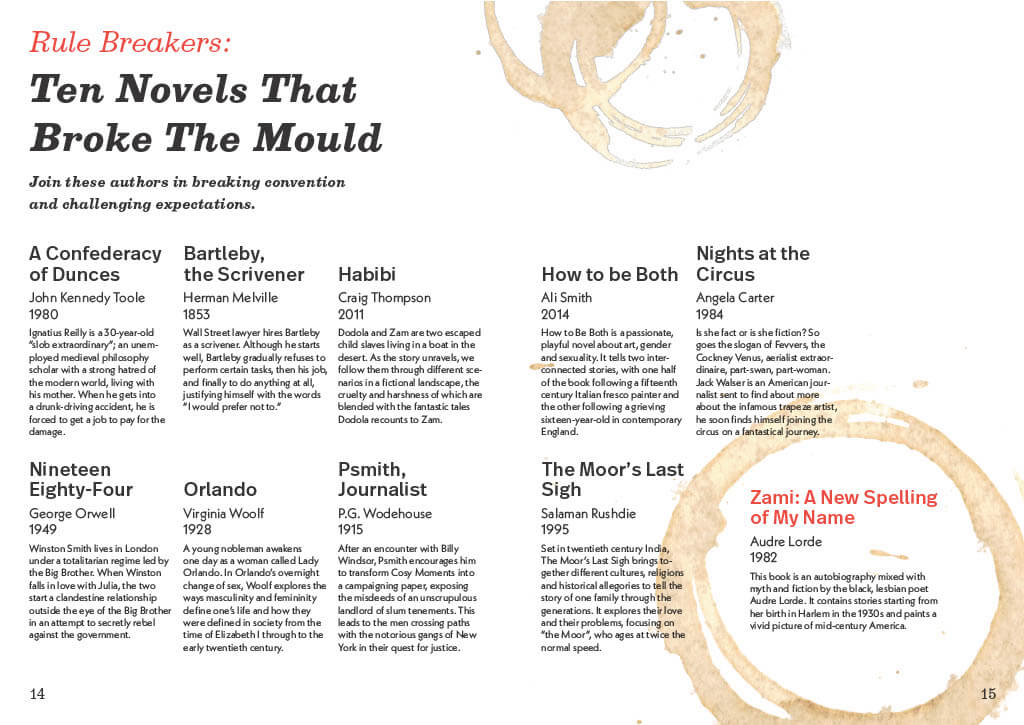
Some Other Alternative Layouts
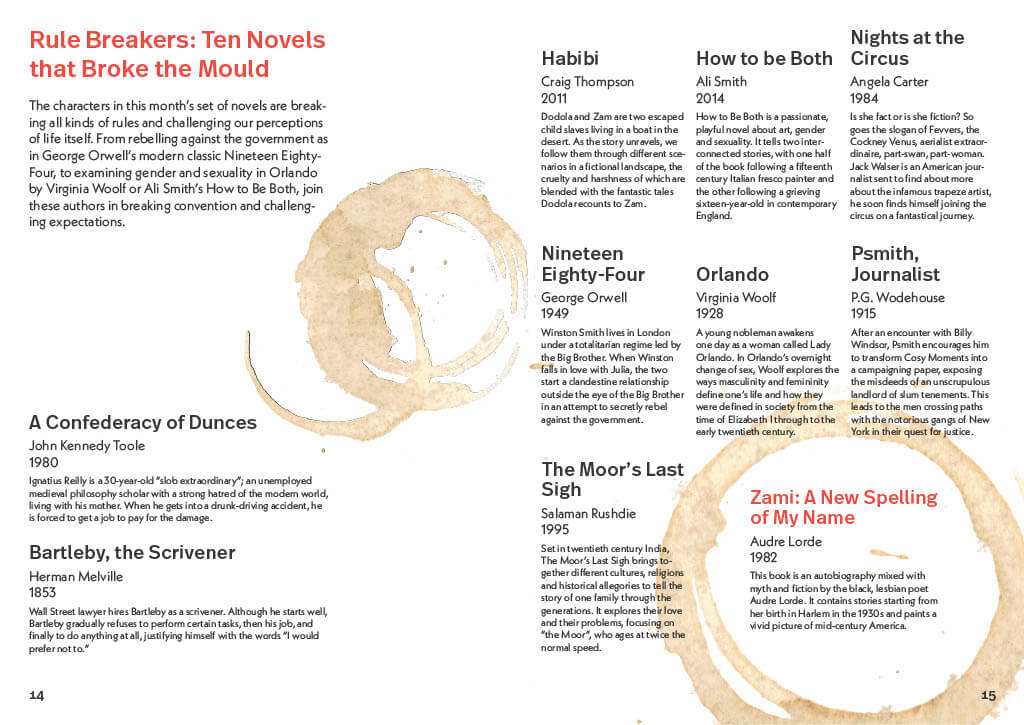
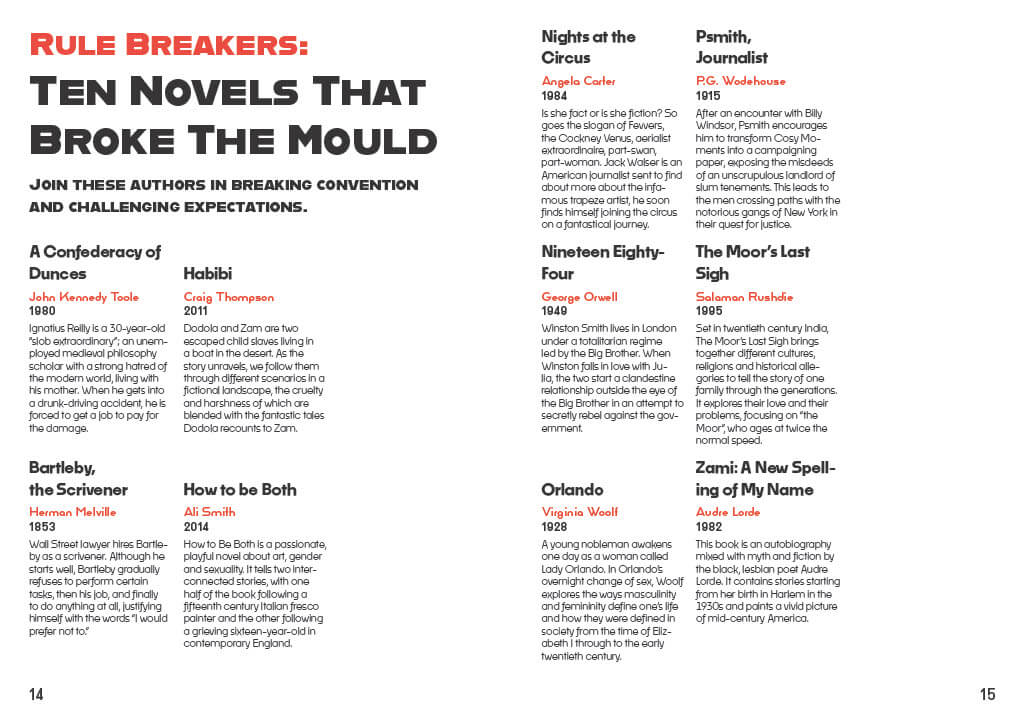
I followed the same grid-style layout for my other designs, as I wanted to see how different I could make each design look while following the same set of “rules”.
Resources That Helped Me Develop My Work
https://helpx.adobe.com/uk/indesign/how-to/margins-and-columns.html
https://www.bbc.co.uk/programmes/articles/nkgnD94Js15YK8pdpJjxFK/rule-breakers-ten-novels-that-broke-the-mould
Designing a brand onboarding system with Bottomline Technologies
Amrita Shrilal has been involved in an exciting new collaboration with Bottomline Technologies this past year. Amrita is one of our MA Communication Design Graphic Design Pathway students graduating this week. She’s also a BA Graphic Communication (Hons) alumnus.
Bottomline focuses on transforming complex business payments and processes into simple, smart, and secure systems. They work with financial companies and institutions globally, and are widely recognised as a payment and collections enterprise. They have banking relations with global banks, UK banks and, building societies, growth banks and payment service providers.
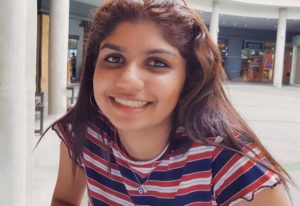
Amrita has a particular passion for user interface design. To develop experience in user interface design for the financial sector, she undertook a design brief for Bottomline’s Head of UX Design (EMEA), Kellie White and, Senior UX Designer and Reading alum, Matthew Standage for her MA professional practice assignment. Dr Jeanne-Louise Moys, MACD Graphic Design and Information Design Pathway lead, supervised her project.
The brief gave Amrita the opportunity to explore approaches to designing a system that allows customers of different-sized businesses to customise the interface design, of a particular product, to match their brand needs. The challenging aspect of the brief was creating a seamless and easy process of designing elements of pages for customers with different levels of expertise on brand and webpage design. It required her to consider ways of presenting complex information and processes in a more straightforward method for end-users. Her design decisions were supported by her research into UX design, market competitors and the development of personas which helped her understand the user and business needs.
Amrita said: “I enjoyed this project as it was different from all the other UX projects I had done in the bachelor programme. It focused on Business-to-Business (B2B) rather than Business-to-Customers (B2C) which is more complex as you need to consider not just the user’s goals but different types of business capabilities and interests. I had to think about how a particular organisation could utilise or benefit from the features of the system to make their process of designing the web interface a seamless experience.”
The outcome of this project was a prototype of an interface system that allows businesses to brand themselves within Bottomline’s products. It considers different user design needs and attempts to make the process of designing interfaces straightforward to those who are not familiar with design conventions or terminology. Some of the features within the system included editing the colour scheme, text styles and button styles.
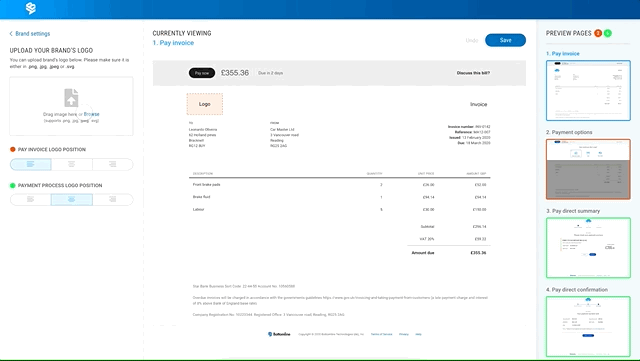
Reflecting on the project, Amrita said: “the project was a stimulating experience as I had to think about different user perceptions of design elements. I had to constantly ask myself whether it would be easily understood by someone without any design experience. Despite that, I enjoyed the opportunity to collaborate with Bottomline on an ongoing project and it helped develop my understanding of UX/UI design”.
Kellie White said: “Amrita did a fantastic job of taking a complex problem and making it simple, a difficult task to accomplish. She worked well to align to good UX process throughout, from research through to ideation and user testing. I was thrilled with the outcome, she achieved a well thought out design solution and growth in her UX skillset through the experience. Well done Amrita! We look forward to future collaboration with the Department.”
Matthew Standage added: “It was a pleasure to collaborate with Amrita and the Department on a professional practice brief. We were not only impressed with the overall quality of the outcome, but also the thorough research and design thinking that went into the process. One of the common challenges in B2B user-experience is striking the balance between complexity and flexibility. The work Amrita produced solves this problem well, using both visual and interaction design techniques to progressively disclose more advanced options to the user and provide guidance when necessary. We look forward to seeing how we can integrate her work and thinking into future product releases.”
This project is the first collaboration between Bottomline and the Department of Typography & Communication. We look forward to exploring new briefs with them for our postgraduate students to work on in the future.
We also look forward to welcoming Matthew back in January for the two-day “Branding and user experience” workshop that he leads for our MA Graphic Design and Information Design pathway students in the spring term.
Reimagining the wayfinding project during the pandemic
In spring term, our MA Communication Design students on the Information Design and Graphic Design pathways have the opportunity to undertake a wayfinding project, as one of their project choices. We usually collaborate with partners in the Reading community (for example, last year we collaborated with The Hexagon) and arrange visits to local sites. The pandemic provided an opportunity to develop new resources for teaching this project.
Wayfinding briefs provide great opportunities for strategic and creative user-centred design. Students have to consider how visual design supports decision-making and user experience of environments, as well as consider the needs and expectations of different users and stakeholders. They also require students to explore the interplay between functional problem-solving and cultural relevance and how branding and identity systems might need to work across a range of different materials and surfaces.
Wayfinding designer, and Reading alum, Joan Zalacain (http://www.zalacain.com/) leads this project. Joan says: “The importance of user-centred design is crucial to wayfinding but we also need systems that are appealing and sit harmoniously within their environment. We strive to convey this to our students as wayfinding is a growing area of international practice and our graduates need to be ready to deliver their best.”
This year, factoring in the impact of Covid-19 restrictions on mobility, we developed a new brief to ensure students did not need to conduct any site visits to undertake the project. Joan worked with architect Maciej Kozak to develop maps and models that students could work with. In professional wayfinding practice, buildings are often at the planning or development stage, so it’s realistic for wayfinding designers to work with these kinds of resources.
This year’s brief envisaged a new community arts centre for Reading. Students worked on either an indoor or an outdoor wayfinding proposal for the centre.
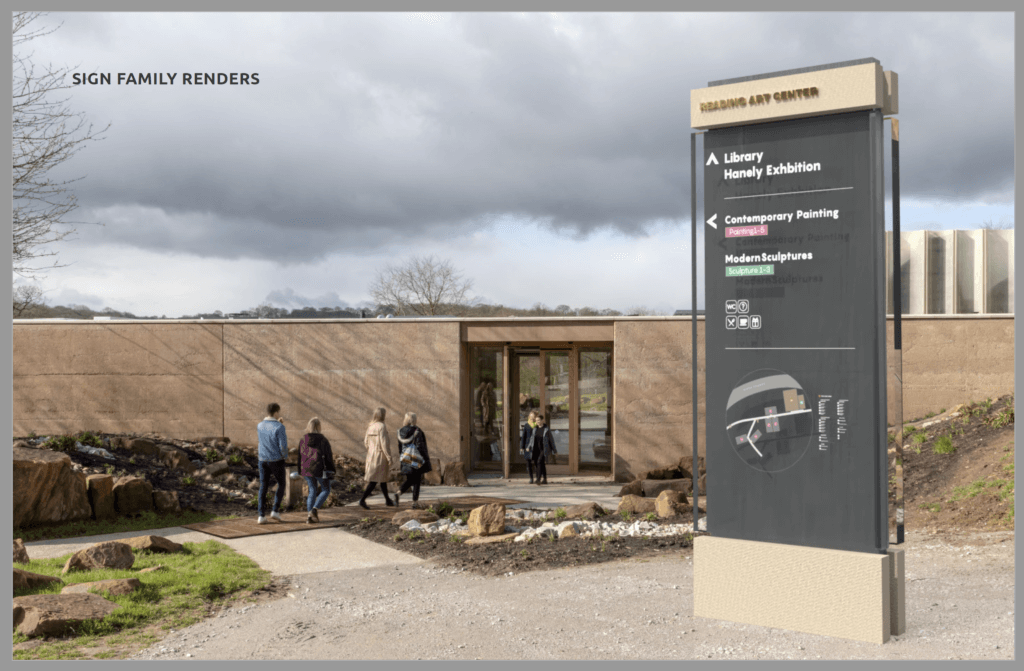
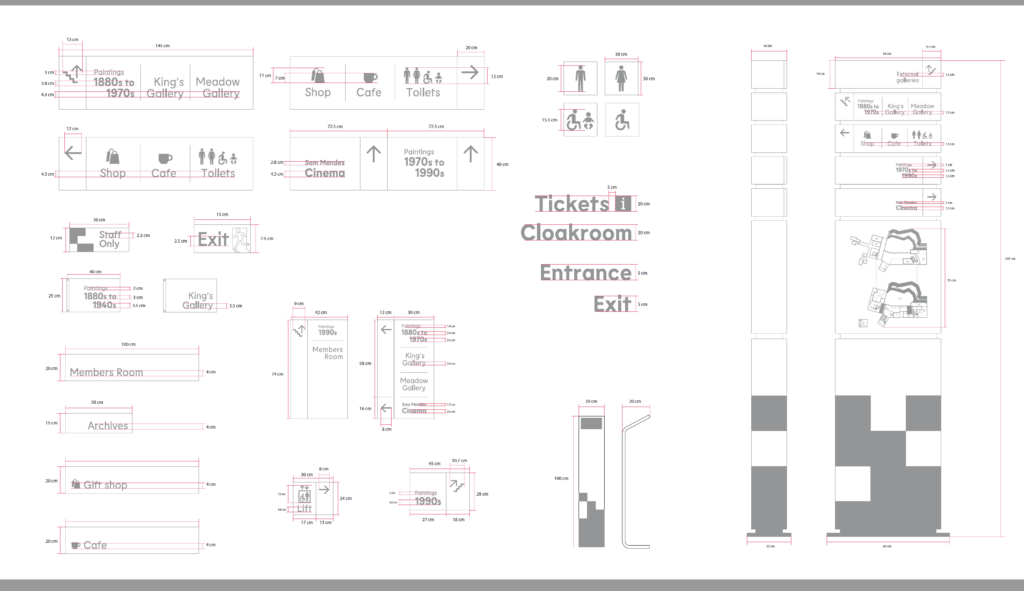
Siobhan Bailey (Graphic Design Pathway and returning alum from our BA programme) said: “I really enjoyed the wayfinding project as it was a completely new area of Graphic Communication that I was not able to study at undergraduate level. Coming from an art and psychology background before graphics, it was a perfect mix of the two and required a high level of critical thinking to meet user needs and solve problems. The skills I have learned throughout this project will be essential for me in terms of wanting to head into the exhibition design, events or wayfinding sectors, and in general for careers which require strategic thinking and initiative. Joan’s passion for wayfinding and user centred design really inspired me and he pushed me to achieve my absolute best at every step of submission.”
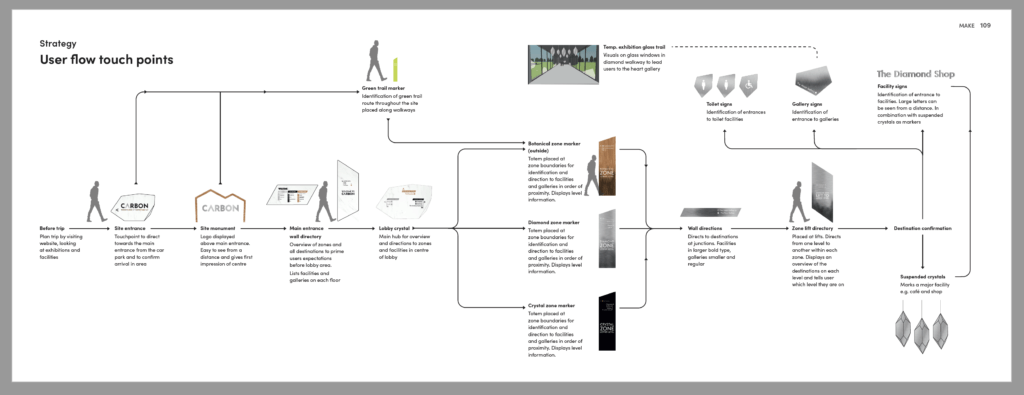
The project also includes a range of inspiring contributions from professional designers and agencies who are part of the Department’s professional network. Thank you to May Chiang from Applied Wayfinding (London), Hayley Branston and Elena McLoughlin from Maynard (London), Anita Meier from Moniteurs (Berlin) who shared their professional insights and Reading PhD graduate, Dr Andrew McIlwraith who shared his expertise on mapping.
Evgenia Vrentzou (Graphic Design Pathway) said: “Through the wayfinding project I learnt to have a more inclusive thinking by considering both the needs of people and the parameters of environment, in order to make an effective, creative and functional system. All the talks during the spring term were very inspiring and we gained important knowledge on how to develop our projects. Wayfinding combines both creativity and strategic thinking and is a part of design that I would like to emphasise even more in the future.”
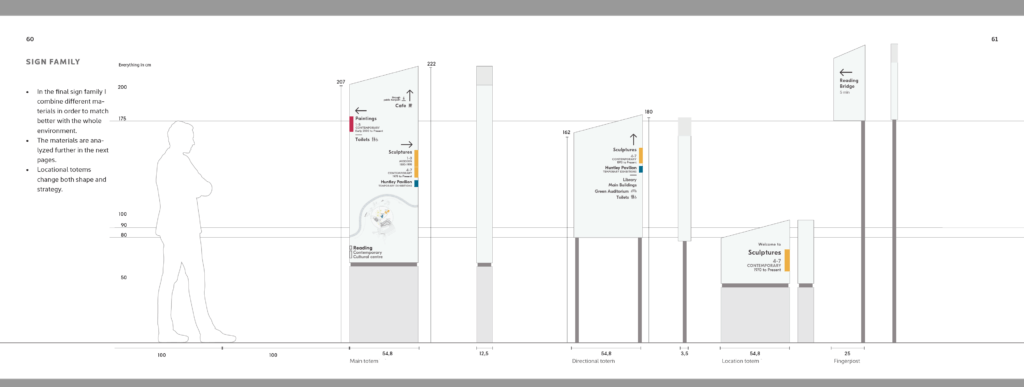
Evgenia also chose to explore wayfinding for her professional practice assignment. In this self-directed project, she designed a new wayfinding system for the coastal city of Heraklion. Her project built on the findings from participant studies she conducted to understand people’s mental maps of the area – a great example of how we incorporate user research into practical projects at Reading.
In his professional practice assignment, Fred extended his experience of wayfinding to consider a journey-planning app that responded to new considerations arising during the pandemic. His wellbeing and urban mobility app – Let’s Walk – focused on supporting people, who might have anxiety about going out during the pandemic but also need to get regular exercise, to identify appropriate places and routes to achieve their goals.
The wayfinding project is open to students on the MA Communication Design Graphic Design and Information Design pathways and MA Creative Enterprise Communication Design pathway. We look forward to running this successful project again with our new cohort in spring 2022.
>A–Z Degree Show: Social Media Presence
Real Job: Angie Bacallan explains how our graduates designed and managed the promotion of their degree show this year: https://www.instagram.com/greaterthanatoz/ https://greater-than-a-to-z.co.uk
